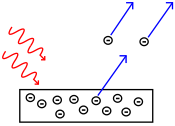Velocity is the rate of change of the position of an object, equivalent to a specification of its speed and direction of motion, e.g. 60 km/h to the north. Velocity is an important concept in kinematics, the branch of classical mechanics which describes the motion of bodies.
Velocity is a vector physical quantity; both magnitude and direction are required to define it. The scalar absolute value (magnitude) of velocity is called "speed", a quantity that is measured in metres per second (m/s or m·s
−1) in the SI (metric) system. For example, "5 metres per second" is a scalar (not a vector), whereas "5 metres per second east" is a vector.
If there is a change in speed, direction, or both, then the object has a changing velocity and is said to be undergoing an
acceleration .
Equation of motion
Velocity is defined as the rate of change of position with respect to time, i.e.

where
v is velocity and
x is the displacement vector. This will give the
instantaneous velocity of a particle, or object, at any particular time
t.
Although the concept of an instantaneous velocity might at first seem
counter-intuitive, it is best considered as the velocity that the object
would continue to travel at if it stopped accelerating at that moment.
Although velocity is defined as the rate of change of position, it is
more common to start with an expression for an object's acceleration
and from there obtain an expression for velocity, which can be done by
evaluating

which comes from the definition of acceleration,

Sometimes it is easier, or even necessary, to work with the
average velocity of an object, that is to say the constant velocity, that would provide the same resultant displacement as a variable velocity,
v(t), over some time period Δt. Average velocity can be calculated as

The average velocity is always less than or equal to the average
speed of an object. This can be seen by realizing that while distance is
always strictly increasing, displacement can increase or decrease in
magnitude as well as change direction.
In terms of a displacement-time graph, the velocity can be thought of
as the gradient of the tangent line to the curve at any point, and the
average velocity as the gradient of the chord line between two points
with
t coordinates equal to the boundaries of the time period for the average velocity.
Constant acceleration
In the special case of constant acceleration, velocity can be studied using the suvat equations. By considering
a as being equal to some arbitrary constant vector, it is trivial to show that

with
v as the velocity at time
t and
u as the velocity at time
t=0. By combining this equation with the suvat equation
x=
ut+
at
2/2, it is possible to relate the displacement and the average velocity by
 .
.
It is also possible to derive an expression for the velocity independent of time, known as the Torricelli equation, as follows:



where v=|
v| etc...
The above equations are valid for both Newtonian mechanics and special relativity.
Where Newtonian mechanics and special relativity differ is in how
different observers would describe the same situation. In particular, in
Newtonian mechanics, all observers agree on the value of t and the
transformation rules for position create a situation in which all
non-accelerating observers would describe the acceleration of an object
with the same values. Neither is true for special relativity. In other
words only relative velocity can be calculated.
Quantities that are dependent on velocity
The kinetic energy of a moving object is dependent on its velocity by the equation

where
Ek is the kinetic energy and
m is the mass. Kinetic energy is a scalar quantity as it depends on the square of the velocity, however a related quantity, momentum, is a vector and defined by

In special relativity, the dimensionless Lorentz Factor appears frequently, and is given by

where γ is the Lorentz factor and
c is the speed of light.






 .
.






 of an ejected electron is given by
of an ejected electron is given by
 is the Planck constant and
is the Planck constant and  is the frequency of the incident photon. The term
is the frequency of the incident photon. The term  is the work function (sometimes denoted
is the work function (sometimes denoted  , or
, or  ),
which gives the minimum energy required to remove a delocalised
electron from the surface of the metal. The work function satisfies
),
which gives the minimum energy required to remove a delocalised
electron from the surface of the metal. The work function satisfies
 is the threshold frequency for the metal. The maximum kinetic energy of an ejected electron is then
is the threshold frequency for the metal. The maximum kinetic energy of an ejected electron is then
 for the photoelectric effect to occur.
for the photoelectric effect to occur.










 )
)











































